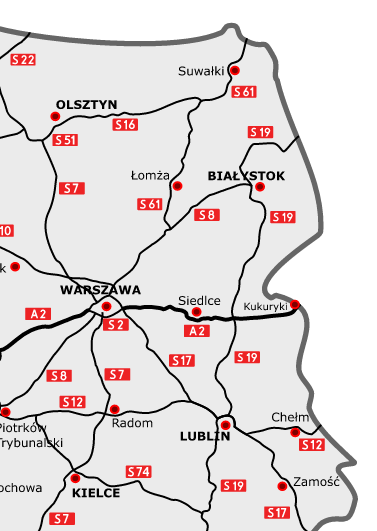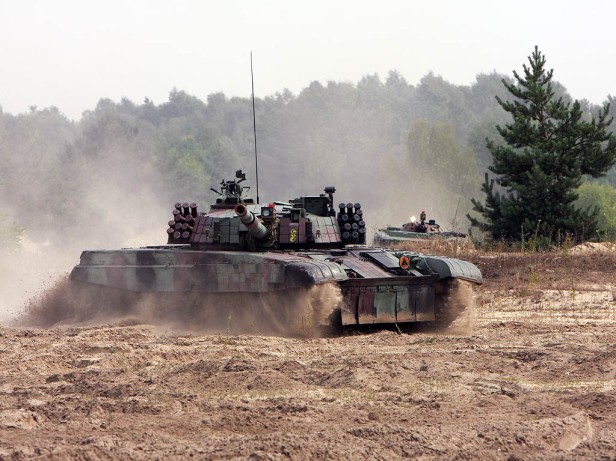In an earlier post, I argued that the Suwałki gap was in fact ill-suited for a full-scale Russian armoured offensive with the goal of linking up Kaliningrad and Belarus, as the terrain and road network did not favour that kind of manoeuvres. This naturally leads to the next question, namely what the alternative would be?

Going south from the gap, the first opportunity is Białystok. The city is the main hub of northeastern Poland, and features a significant amount of both roads and railroads, and has the benefit of being approachable from Belarus along two major road, Grodno-Białystok from the northeast and Baranovichi-Białystok from the East. From there it is possible to either turn north towards Suwałki (along E67, not visible on map) or southwest towards Warsaw. However, the areas east of the city are heavily forested, and it represents a significant detour if the aim is to reach Suwałki from Grodno.
However, the route that promises a decisive victory fast, as well as dragging away Polish reinforcements from the Kaliningrad/Suwałki-region, is the E30/A2 road from Minsk via Brest and on to Warsaw. Brest is located directly on the eastern bank of the river Bug, which in this area marks the border between Poland and Belarus. Striking out from Brest would make it possible to potentially take the border bridges over Bug in a coup, or at the very least prepare the crossings on allied territory. Here, the E30 as well as the twin-rail railroad would provide a crucial lifeline for the advancing forces, and the right flank would be protected by the Bug.

This is not a new idea. In the summer of 1944, the Soviet Operation Bagration included a major offensive in the Lublin-Brest area, where the Soviet forces (including the Polish 1st Army that was transfered from the Lviv sector halfway through the operation) captured bridgeheads over Vistula at Magnuszew and Puławy (approximately 60 and 100 km south of Warszaw) and over Narew at Serock (40 km north of the capital). However, the Polish capital did not change hands until the launching of the Vistula-Oder offensive in January the following year, a controversial fact from a Polish point view.
As noted, this would be a major treat towards the Polish capital, and it is very likely that Poland would direct at least two of its three main divisions to meet this. In practice, the 16th ‘Pomorska‘ Mechanised Division would be left to deal with Kaliningrad, creating a situation where both sides would be roughly comparable, and causing a stalemate around the exclave. This would likely be in the interest of Russia, compared to an offensive closer to the Suwałki gap which would make it easier for Poland to shift troops from one front to the other, thereby negating part of Russia’s quantitative superiority.
The downside to these military upsides is that while a ‘disturbance’ in the Baltic region could perhaps be caused to look like a Ukraine-scenario, thereby delaying a NATO-reaction during the critical first days, an armoured corps moving west along the E30 would be a sure way of launching WWIII, especially as Germany would be far more likely to intervene if the advancing Russians where on the (literal) highway to Berlin than if they occupied Vilnius.

This is obviously not something that hasn’t crossed the minds of the Polish general staff, and the above-mentioned 16th Division actually has an additional armoured brigade in the form of the 1st ‘Warszawska‘ Armoured Brigade equipped with PT-91 Twardy (modernised T-72), BWP-1 (local-designation for BMP-1), and 2S1 Gvozdika. The brigade is headquartered in the Wesoła district on the eastern outskirts of Warsaw. In other words, it is located on the ‘right side’ of both the Bug and the Vistula, and as such is well-placed to meet any offensive along the Brest-Warsaw axis. However, the equipment is rather old, and while the Twardy is a significant step up from the T-72, it is still far from the latest generation of tanks.
As such, it is a noteworthy move when the Polish Defence Forces announce that a tank battalion from the 11th ‘Lubuska‘ Armoured Cavalry Division in the southwestern parts of Poland is set to transfer to Wesoła. This is to make room for the US Army units coming to Żagań, currently home to the division’s 34th Armoured Cavalry Brigade. The 34th sport two battalion equipped with the Leopard 2A5, currently Poland’s most modern main-battle tank. Moving one of these battalions East of the Vistula radically alters the number of units available to the Polish in this key area during the first day or so after mobilisation. It does seem like the Polish Army has recognised the need to be able to concentrate more high-quality units in defence of the capital at shorter notice, and comes as part of a trend in which the West tries to shorten response times in general, and with a focus on heavier units in particular. This is also evident from a Finnish perspective, and both the recent transfer of older Leopard 2A4’s to ‘new’ units and the creation of fast response units in the Army can be seen as part of this very same trend.


“home to the division’s 34th Armoured Cavalry Battalion. The 34th sport two battalion equipped with the Leopard 2A5, currently Poland’s most modern main-battle tank.” Surely this must be a typo?
You’re absolutely correct. The 34th is a brigade-sized unit. Thanks!
What do you think about the role of artillery in a short lasting Russian invasion of Poland, meaning one in which the US has not established air dominance? I am no expert on artillery but I could envision that Russian artillery would outmass anything the Poles have and would be bad news for Polish land forces of all sorts. Even if not hit directly, Polish forces might have to focus on avoiding being targeted and would be unable to move long distances in sizes appropriate for maneuver warfare.
But doesn’t the Polish army have quite a lot of artillery in stock and more is ordered? (Except maybe for long range rocket artillery)